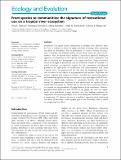Files in this item
From species to communities : the signature of recreational use on a tropical river ecosystem
Item metadata
| dc.contributor.author | Deacon, Amy Elizabeth | |
| dc.contributor.author | Shimadzu, Hideyasu | |
| dc.contributor.author | Dornelas, Maria | |
| dc.contributor.author | Ramnarine, Indar W. | |
| dc.contributor.author | Magurran, Anne | |
| dc.date.accessioned | 2015-11-13T10:10:02Z | |
| dc.date.available | 2015-11-13T10:10:02Z | |
| dc.date.issued | 2015-12 | |
| dc.identifier | 230680216 | |
| dc.identifier | 55a2f172-b0c2-462f-a475-9be8fefd1852 | |
| dc.identifier | 84953639355 | |
| dc.identifier | 000367433000011 | |
| dc.identifier.citation | Deacon , A E , Shimadzu , H , Dornelas , M , Ramnarine , I W & Magurran , A 2015 , ' From species to communities : the signature of recreational use on a tropical river ecosystem ' , Ecology and Evolution , vol. 5 , no. 23 , pp. 5561-5572 . https://doi.org/10.1002/ece3.1800 | en |
| dc.identifier.issn | 2045-7758 | |
| dc.identifier.other | Bibtex: urn:04ed5f2700fdabdab05378e87d9019a8 | |
| dc.identifier.other | ORCID: /0000-0002-0036-2795/work/43550262 | |
| dc.identifier.uri | https://hdl.handle.net/10023/7780 | |
| dc.description | This work was funded by an ERC grant (BIOTIME 250189). A. E. M. thanks the Royal Society and M. D. thanks the Scottish Funding Council (MASTS HR09011) for support. | en |
| dc.description.abstract | Disturbance can impact natural communities in multiple ways. However, there has been a tendency to focus on single indicators of change when examining the effects of disturbance. This is problematic as classical diversity measures, such as Shannon and Simpson indices, do not always detect the effects of disturbance. Here, we instead take a multilevel, hierarchical approach, looking for signatures of disturbance in the capacity and diversity of the community, and also in allocation and demography at the population level. Using recreational use as an example of disturbance, and the freshwater streams of Trinidad as a model ecosystem, we repeatedly sampled the fish communities and physical parameters of eight pairs of recreational and nonrecreational sites every 3 months over a 28-month period. We also chose the Trinidadian guppy (Poecilia reticulata) as the subject of our population-level analyses. Regression tree analysis, together with analysis of deviance, revealed that community capacity and community species richness were greater at sites with higher levels of recreational use. Interestingly, measures of community diversity that took into account the proportional abundance of each species were not significantly associated with recreational use. Neither did we find any direct association between recreational use and proportion of guppy biomass in the community. However, population-level differences were detected in the guppy: Sex ratio was significantly more male-biased at more disturbed sites. Our findings emphasize the importance of considering multiple levels when asking how disturbance impacts a community. We advocate the use of a multilevel approach when monitoring the effects of disturbance, and highlight gaps in our knowledge when it comes to interpreting these effects. | |
| dc.format.extent | 12 | |
| dc.format.extent | 1332303 | |
| dc.language.iso | eng | |
| dc.relation.ispartof | Ecology and Evolution | en |
| dc.subject | Allocation rules | en |
| dc.subject | Anthropogenic disturbance | en |
| dc.subject | Biodiversity | en |
| dc.subject | Community capacity | en |
| dc.subject | Diversity indices | en |
| dc.subject | Ecosystem services | en |
| dc.subject | Freshwater ecology | en |
| dc.subject | Poecilia reticulata | en |
| dc.subject | QH301 Biology | en |
| dc.subject | SDG 15 - Life on Land | en |
| dc.subject.lcc | QH301 | en |
| dc.title | From species to communities : the signature of recreational use on a tropical river ecosystem | en |
| dc.type | Journal article | en |
| dc.contributor.sponsor | European Research Council | en |
| dc.contributor.institution | University of St Andrews. School of Biology | en |
| dc.contributor.institution | University of St Andrews. Fish Behaviour and Biodiversity Research Group | en |
| dc.contributor.institution | University of St Andrews. Marine Alliance for Science & Technology Scotland | en |
| dc.contributor.institution | University of St Andrews. Scottish Oceans Institute | en |
| dc.contributor.institution | University of St Andrews. Institute of Behavioural and Neural Sciences | en |
| dc.contributor.institution | University of St Andrews. St Andrews Sustainability Institute | en |
| dc.contributor.institution | University of St Andrews. Centre for Research into Ecological & Environmental Modelling | en |
| dc.contributor.institution | University of St Andrews. Centre for Biological Diversity | en |
| dc.identifier.doi | https://doi.org/10.1002/ece3.1800 | |
| dc.description.status | Peer reviewed | en |
| dc.identifier.url | http://onlinelibrary.wiley.com/doi/10.1002/ece3.1800/suppinfo | en |
| dc.identifier.grantnumber | 250189 | en |
This item appears in the following Collection(s)
Items in the St Andrews Research Repository are protected by copyright, with all rights reserved, unless otherwise indicated.

